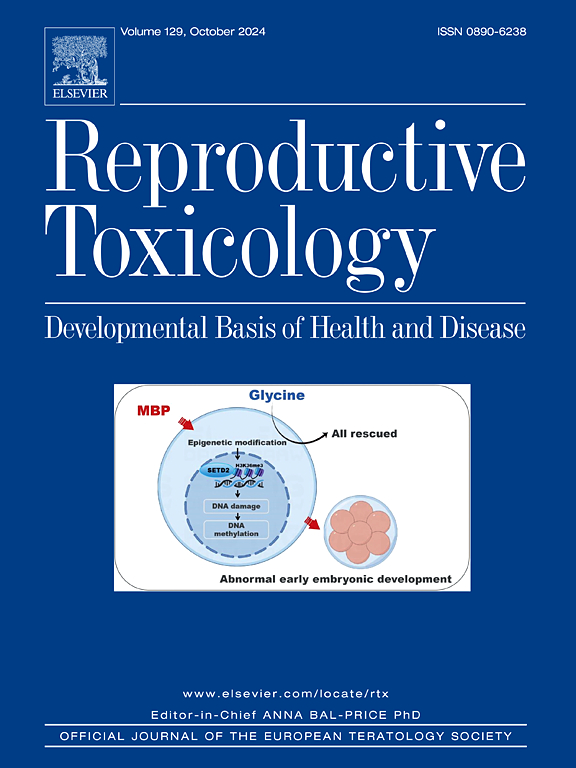The role of ATG7-mediated ferroptosis in formaldehyde-induced ovarian injury in rats
IF 2.8
4区 医学
Q2 REPRODUCTIVE BIOLOGY
引用次数: 0
Abstract
Background
To investigate the mechanisms of toxicological damage of formaldehyde to the female reproductive system
Methods
A Mendelian randomization method was used to predict a causal relationship between ferroptosis genes and female infertility. Changes in the structure and function of rat ovaries were observed by HE staining and transmission electron microscopy. Combined with molecular experiments, we verified the alterations of GSH, iron ions, MDA levels, and the expression of ferroptosis genes.
Results
Mendelian randomization suggested a significant causal relationship between ATG7 and female infertility. Animal experiments showed that formaldehyde caused abnormal follicular maturation and ovarian mitochondrial alterations. Meanwhile, formaldehyde induced elevated levels of iron ions and MDA and decreased GSH levels. Further detection by Western blotting and qRT-PCR revealed that the expression of the ferroptosis marker gene GPX4 decreased and ATG7 increased in the ovary after formaldehyde stimulation.
Conclusions
Formaldehyde affected the structure and physiological function of rat ovary by activating the expression level of ATG7 and inhibiting the activity of GPX4, which caused iron overload and elevated levels of peroxides, leading to the occurrence of ferroptosis in ovarian tissue.
atg7介导的铁下垂在甲醛致大鼠卵巢损伤中的作用。
背景:探讨甲醛对女性生殖系统毒理学损害的机制方法:采用孟德尔随机化方法预测下垂铁基因与女性不育之间的因果关系。用HE染色和透射电镜观察大鼠卵巢结构和功能的变化。结合分子实验,我们验证了GSH、铁离子、MDA水平和铁下垂基因表达的变化。结果:孟德尔随机化提示ATG7与女性不孕症之间存在显著的因果关系。动物实验表明,甲醛引起卵泡成熟异常和卵巢线粒体改变。同时,甲醛引起铁离子和丙二醛水平升高,GSH水平降低。进一步的Western blotting和qRT-PCR检测发现,甲醛刺激后卵巢中铁下垂标志基因GPX4表达降低,ATG7表达升高。结论:甲醛通过激活ATG7表达水平、抑制GPX4活性影响大鼠卵巢结构和生理功能,导致铁超载、过氧化物水平升高,导致卵巢组织发生铁下垂。
本文章由计算机程序翻译,如有差异,请以英文原文为准。
求助全文
约1分钟内获得全文
求助全文
来源期刊

Reproductive toxicology
生物-毒理学
CiteScore
6.50
自引率
3.00%
发文量
131
审稿时长
45 days
期刊介绍:
Drawing from a large number of disciplines, Reproductive Toxicology publishes timely, original research on the influence of chemical and physical agents on reproduction. Written by and for obstetricians, pediatricians, embryologists, teratologists, geneticists, toxicologists, andrologists, and others interested in detecting potential reproductive hazards, the journal is a forum for communication among researchers and practitioners. Articles focus on the application of in vitro, animal and clinical research to the practice of clinical medicine.
All aspects of reproduction are within the scope of Reproductive Toxicology, including the formation and maturation of male and female gametes, sexual function, the events surrounding the fusion of gametes and the development of the fertilized ovum, nourishment and transport of the conceptus within the genital tract, implantation, embryogenesis, intrauterine growth, placentation and placental function, parturition, lactation and neonatal survival. Adverse reproductive effects in males will be considered as significant as adverse effects occurring in females. To provide a balanced presentation of approaches, equal emphasis will be given to clinical and animal or in vitro work. Typical end points that will be studied by contributors include infertility, sexual dysfunction, spontaneous abortion, malformations, abnormal histogenesis, stillbirth, intrauterine growth retardation, prematurity, behavioral abnormalities, and perinatal mortality.
 求助内容:
求助内容: 应助结果提醒方式:
应助结果提醒方式:


